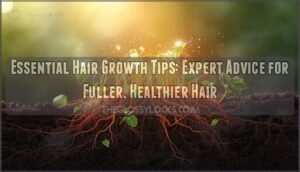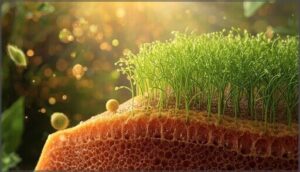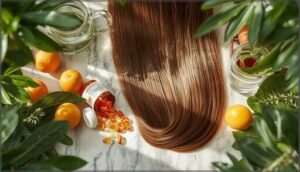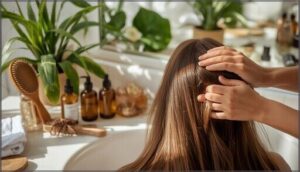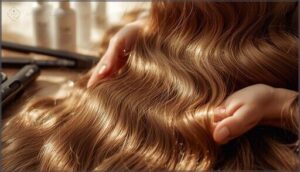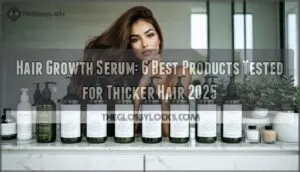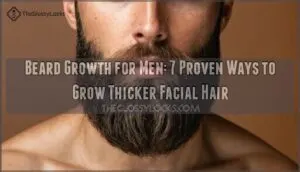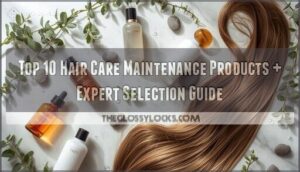This site is supported by our readers. We may earn a commission, at no cost to you, if you purchase through links.
Your hair follicles don’t operate in isolation—they’re part of a complex ecosystem where circulation, nutrition, and cellular turnover all converge. When any of these systems falls out of balance, you’ll see it reflected in slower growth, increased shedding, or strands that break before reaching their potential.
The good news is that most hair growth barriers aren’t genetic dead ends; they’re correctable through targeted changes in how you care for your scalp, fuel your body, and manage daily stressors. These hair growth tips address the underlying mechanisms that keep follicles active and strands resilient, giving you a practical framework to work with your biology rather than against it.
Table Of Contents
Key Takeaways
- Healthy hair starts with a balanced scalp—prioritize gentle cleansing, regular massage, and targeted treatments to keep follicles thriving.
- Eating a diet rich in protein, iron, zinc, and healthy fats is essential for building stronger, fuller hair from the inside out.
- Limiting heat styling, harsh chemicals, and adopting gentle detangling and regular trims protect hair from breakage and thinning.
- Managing stress, getting enough sleep, and steering clear of smoking or excess alcohol can dramatically boost your hair’s growth and resilience.
Optimize Your Scalp for Hair Growth
A healthy scalp is the foundation for stronger, fuller hair. Taking care of your scalp can make a real difference in growth and overall hair quality.
Here’s what you should keep in mind as you focus on scalp health.
Importance of a Healthy Scalp
Think of your scalp as the soil for your hair—when it’s healthy, everything thrives. A balanced scalp microbiome strengthens your barrier function, helping hair follicles grow full and strong. Chronic inflammation has the opposite effect, causing shedding or breakage.
A healthy scalp acts like rich soil, nurturing hair follicles for fuller, stronger growth while inflammation disrupts this foundation
Epidemiological trends show that addressing scalp disorders early, and using targeted scalp treatments for hair, makes a lasting difference. Untreated inflammation can reduce the nutrient supply to hair follicles.
Scalp Massage Techniques
A routine scalp massage helps boost scalp circulation and hair growth stimulation. Use your fingertips or massage tools to target pressure points, working in gentle, circular motions.
Technique variations matter, so experiment to find what feels right. For extra benefit, infuse your scalp massage with an essential oil.
Regular massages can help with improved hair thickness. Most people see improvements after 5–10 minutes daily, several days a week.
Scalp Exfoliation and Cleansing
As you care for your scalp, think of exfoliation as giving it a fresh start. A gentle scalp scrub or cleansing treatment lifts away buildup, keeps your microbiome balanced, and encourages healthy blood flow.
Tailor exfoliation frequency to your scalp type. The right approach eases scalp disorders and sets the stage for stronger hair growth—just like regular massage encourages.
Choosing Scalp Serums and Treatments
After a good scrub, it’s time to target your scalp’s specific needs with the right serum or medicated topical treatment. Matching serum ingredients and application methods to your scalp type helps boost benefits. Look for professional advice when possible, and always check product safety labels.
- Hydrating serums for dryness
- Peptide-rich for thinning
- Clarifying for oil-control
- Calming for irritation
Eat a Nutrient-Rich Diet
The food you eat shapes every strand on your head, from root to tip. Eating well isn’t just good for your body—it’s fundamental for stronger, healthier hair.
Here’s what to look for when building a diet that aids hair growth.
Key Vitamins and Minerals for Hair Growth
Your hair leans on a foundation of powerful nutrients. Vitamin D, iron, and zinc create the roots for strong growth and reduced shedding. Biotin acts like scaffolding, reinforcing strand thickness. Vitamin C and E protect from breakage and boost new growth.
Foods rich in these vitamins and minerals are your best allies for hair nutrition.
Protein and Healthy Fats for Hair Health
If you’ve ever wondered why nutrition matters so much for hair, here’s the answer: protein fuels keratin production, building strands from the inside out. Skimping on protein causes shedding and sluggish regrowth.
Likewise, healthy fats—especially those rich in omega-3s—add resilience and moisture. Amino acids and dietary fats form the backbone of a balanced diet for thriving hair growth.
Foods to Include and Avoid
Nutrition shapes stronger, fuller hair—think of diet as the silent architect behind every strand. Prioritize nutrient absorption by loading up on leafy greens, sweet peppers, and protein sources like lentils and salmon.
Modern diet trends, especially those packed with sugars and processed foods, can work against key vitamins essential for growth. Balance is your best bet for visible, lasting results.
Hydration and Its Effect on Hair
Think of water as the lifeblood of vibrant strands—Scalp Hydration keeps follicles in top shape and stops dryness before it shatters your hair’s defenses.
Adequate Water Intake aids Shaft Strength and elasticity, while Humidity Effects can change hair cuticles, sometimes boosting shine.
Even a little dehydration tips the balance, raising your risk of breakage and fragile growth.
Consider Hair Growth Supplements
Supplements can be helpful when diet alone isn’t enough to support healthy hair growth. They work best when you understand what your hair actually needs.
Here’s what to know about common options and how they fit into your routine.
Biotin and Collagen Benefits
Consider this: if your body’s running low on building blocks, even the best hair growth supplements can’t work magic. Biotin mechanisms spark keratin production, but only if you’re actually short on it.
Collagen absorption matters for strengthening strands, though the clinical evidence is stronger for hair resistance, not new growth.
Supplement safety is good, but check for deficiency prevalence before you start.
Omega-3 Fatty Acids
Wondering where to start with nutrition and hair growth? Omega-3 fatty acids deliver a noticeable boost. Clinical trials show the right omega-3 dosage can increase hair density and scalp hydration over several months.
They work from the inside out, supporting a balanced diet for hair growth and helping your follicles thrive—especially when part of a well-rounded hair growth and diet plan.
Vitamin D, Iron, and Zinc
While omega-3s nurture from within, hair growth also depends on mineral synergies. Vitamin D deficiency often leads to thinning, while iron supplementation targets hair loss caused by low ferritin. Zinc intake aids healthy follicles, working alongside iron and vitamins.
Prioritize dietary sources: eggs, lentils, salmon, and pumpkin seeds offer the nutrients your hair needs to stay strong and resilient.
Safe Supplement Use and Potential Risks
Supplements for hair growth might sound straightforward, but there’s more to think about than just picking a popular vitamin off the shelf. High-dose biotin can interfere with lab tests, while undisclosed ingredients raise labeling accuracy questions.
Adverse effects—like mild digestive upset—or drug interactions are possible. Always weigh dosage concerns carefully. When in doubt, discuss hair supplements with your healthcare provider.
Practice Healthy Hair Care Habits
The way you care for your hair each day carries more weight than you might think. Simple habits can make a real difference in keeping strands strong and healthy.
Let’s look at a few key practices worth working into your routine.
Gentle Brushing and Detangling
Although it seems simple, choosing the right comb material and bristle type transforms your hair care routine, promoting oil distribution and breakage reduction.
Use a widetooth comb for wet detangling, especially if your hair is fragile or curly, and opt for soft bristles. Brushing this way helps prevent hair breakage—a foundation for most effective hair growth tips.
Regular Trims to Prevent Split Ends
Regular trims are your hair’s silent ally for length retention and breakage prevention. When split ends form, they travel up the shaft, causing more harm than good. Routine haircuts serve as damage control. Most industry recommendations for trim frequency suggest you:
- Trim every 8–12 weeks
- Focus on ends, not overall length
- Adjust for your hair type
- Prioritize consistent care
Limiting Hair Washing Frequency
While everyone’s hair care routine is unique, limiting hair washing frequency is key. Over-washing strips natural oils, while under-washing leads to Sebum Accumulation, upsetting your Scalp Microbiome.
Your Hair Type and Wash Tolerance matter—straight hair spreads oil faster, while curls retain moisture longer.
Product Choice also affects outcomes, so find a rhythm that balances clean hair and scalp health.
Choosing Strengthening Shampoos and Conditioners
When you’re scanning shelves for shampoos or conditioner, look for hair care products with protein formulas and ceramide benefits—they help reinforce hair strength from the inside out. Skip harsh cleansers; gentle, mild surfactants are friendlier to your scalp.
Humectant polymers add moisture and flexibility, while “thickening” or biotin shampoos mostly boost the feel, not actual hair growth.
Minimize Heat and Chemical Damage
Heat and chemicals can quietly undermine your efforts to grow fuller, healthier hair. Knowing how to limit this kind of damage is key. Here’s what to focus on next.
Reducing Heat Styling Tool Usage
Ever notice how hair feels brittle after heat styling? That’s heat damage at work. For healthy growth, prioritize heat damage repair: swap daily blowouts for protective styling methods, and keep temperature control front and center.
Always use proper heat protectant application, and consider alternative styling tools. Little changes to your hair care routine make a big dent in breakage and support lasting strength.
Safe Coloring and Chemical Treatments
Changing your hair color can feel uplifting, but chemical hair treatments are a double-edged sword—think vibrant results but possible cuticle damage and hair breakage. Lean into ammonia-free dyes or PPD alternatives, especially for vivid colors. Always patch test before coloring.
Salon or at-home, prevention matters: minimize hair damage with proper hair treatment choices if growth and strength are your goals.
Using Heat Protectants
Protecting your hair from heat styling isn’t just smart—it’s essential for healthy hair growth. Using a heat protectant forms a barrier that cuts heat damage by up to 50%, reducing breakage and brittleness. Choose formulas backed by ingredient efficacy and apply on damp hair.
Current market trends favor multi-benefit products, matching evolving user behavior in daily hair care.
Signs of Hair Damage to Watch For
Think your hair just feels a bit off? Dryness, brittleness, and increased shedding are your first red flags. Watch for these three signs of hair damage:
- Hair breaks or sheds more than usual, leaving strands everywhere.
- Texture changes—what should feel smooth now feels rough or frizzy.
- Split ends and thin, fragile tips signal deeper hair breakage.
Manage Lifestyle Factors for Better Growth
Your daily habits play a big role in how well your hair grows. Some lifestyle choices can quietly work against your progress, while positive changes make a real difference over time.
Let’s look at a few key steps you can take to give your hair the best shot at healthy growth.
Stress Reduction Techniques
When life ramps up stress, hair often bears the brunt. Managing stress levels is key for hair growth, so build rituals that soothe both mind and scalp.
Yoga benefits extend beyond flexibility—its deep breathing exercises taper cortisol spikes. Meditation practice restores balance, while scalp massage and creative outlets directly lower the effects of stress on hair.
Use the table below to guide your routine.
| Technique | How It Helps Hair Growth |
|---|---|
| Yoga Benefits | Lowers cortisol, boosts blood flow |
| Meditation Practice | Reduces stress, normalizes growth cycle |
| Breathing Exercises | Decreases hair shedding |
| Scalp Massage | Enhances root nourishment |
| Creative Outlets | Aids hair retention |
Regular Exercise Benefits
Just as stress can hold your hair back, regular exercise opens the door for growth. When you move, you boost blood flow, delivering more nutrients to your scalp.
The right exercise patterns help regulate hormones and lower oxidative stress, which promotes hair health. These systemic health benefits make regular activity a reliable part of your hair growth strategies.
Adequate Sleep for Hair Health
A full night’s sleep is a hidden ally in hair growth and lifestyle routines. When you keep your sleep duration steady, your body balances hormones and lowers stress impact—both big factors for healthy hair.
During deep sleep, blood flow to the scalp improves, delivering nutrients. Favoring a consistent circadian rhythm helps your hair grow stronger, longer, and healthier.
Avoiding Smoking and Harmful Habits
Just as steady sleep fuels hair, steering clear of smoking and harmful habits shields your hair from preventable loss. Smoking Alopecia, Vaping Effects, and even Alcohol Intake all hinder hair growth. Protect your hair health with these practices:
- Avoid smoking and vaping
- Limit alcohol intake
- Minimize drug exposure
- Focus on healthy habits
- Prevent nicotine vasoconstriction
Frequently Asked Questions (FAQs)
How long does it take to see new hair growth?
Most people notice new hair growth in about three to six months. Growth Timeline varies—factors like Cycle Phases, Loss Severity, or ongoing Treatment Regrowth all Affecting Visibility. Patience is key, as the hair growth cycle naturally unfolds.
What causes abrupt, patchy hair loss?
Sudden strands slipping away? Abrupt, patchy hair loss often signals conditions like Alopecia Areata, Telogen Effluvium, Scalp Infections, Scarring Alopecia, or Anagen Effluvium, all impacting hair follicles and leading to unexpected hair shedding.
Can hairstyles or tension lead to hair loss?
Tight hairstyles—think braids, ponytails, or weaves—can trigger Traction Alopecia by putting constant tension on hair roots. This recurring pull leads to follicle damage, hair loss, and breakage, so prevention tips and gentle styling are essential.
Are medical treatments for hair growth safe?
Imagine swapping a bad haircut for surprise side effects—ironic, isn’t it?
Hair loss treatments like minoxidil and finasteride can help, but minor risks like irritation or rare complications from PRP, microneedling, or laser therapy warrant informed choices.
Does age affect hair growth rate and thickness?
As you age, the Anagen phase length shortens, meaning slower hair growth. Hair density declines and strand thickness decreases, often due to hormonal influence and follicle miniaturization—so hair thinning and reduced hair thickness become more noticeable.
Conclusion
Think of your hair as a thriving city, its energy powered by rivers of nutrients and care flowing beneath the surface. Consistent attention to scalp health, diet, and gentle maintenance isn’t just good advice—it’s the blueprint for resilience and fullness.
Because in the landscape of hair growth tips, every habit becomes architecture, each choice laying a stronger foundation. When you treat your follicles like builders, they can work wonders—delivering strands that reflect the strength invested from the roots up.

